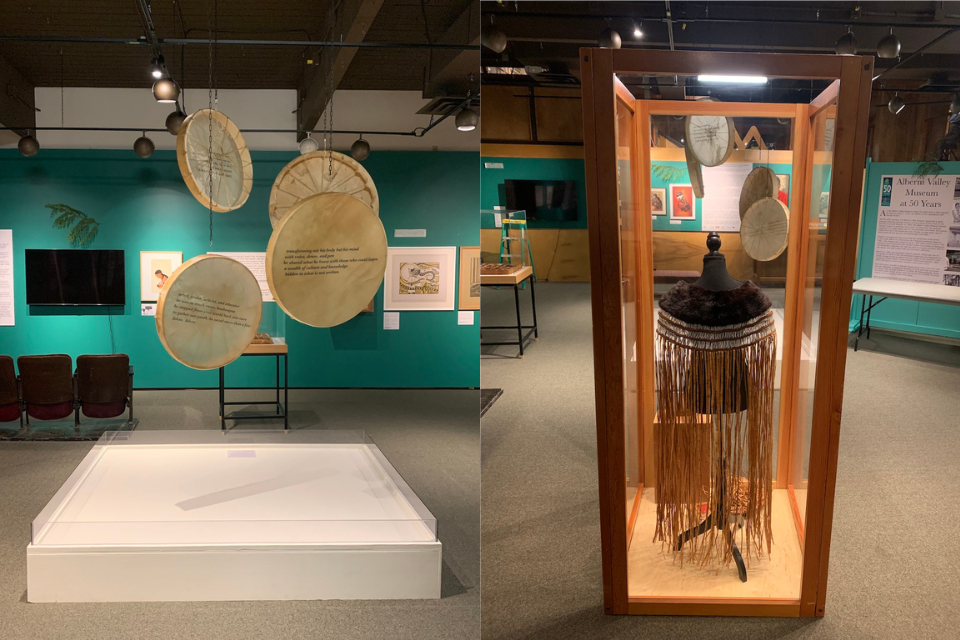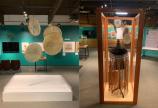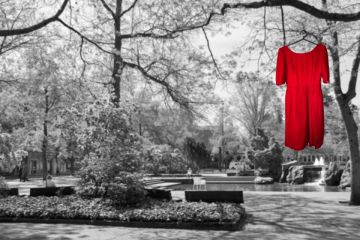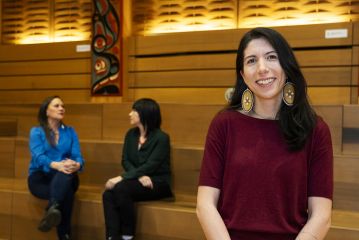Nuu-chah-nulth knowledge, teachings and ways of knowing
- Anne MacLaurin

A powerful new exhibit of over 51 original and reproduction works by a c̓išaaʔatḥ (Tseshaht) artist, scholar/educator, activist and actor—George Clutesi (1905-1988)— is on during Indigenous Peoples History Month at the Alberni Valley Museum in Port Alberni until Sept. 2.
nuučaan̓ułʔatḥ scholar and UVic assistant professor in anthropology, hiininaasimm Tommy Happynook, is a contributor to the exhibit. The exhibition features four large drums suspended from the gallery ceiling, allowing visitors to walk around them. The title of the piece is "The Silent Song That Was Not Written."
This piece is a physical representation of how I understand Clutesi’s literary work. My words, both the nuučaan̓uł and English, represent my own song in response to Clutesi’s writing. The drums represent my connection to nuučaan̓uł lands, waters, skies, ancestors, and the many human and non-human beings we are in relationships with throughout our world. The suspended drums create sound through their movements and bring life to my silent song.
—hiininaasimm, Tommy Happynook
“I am very thankful to have been invited into the exhibition as a contributor,” says Happynook. “I am very grateful to Deb and Ron George and their sons for the help in making the drums and Emily Thiessen for screen printing my words onto the drums—these relationships were instrumental to the presentation of my piece.”
Happynook joins another UVic nuučaan̓ułʔatḥ scholar and assistant professor in Indigenous Governance, sii-yaa-ilth-supt Dawn Smith. In her piece titled "Family Shawl," Smith considers Clutesi’s scholarship and writing through her creation of women's regalia as nuučaan̓ułʔatḥ knowledge.
“The power of Clutesi’s words echo in his book Potlatch (1967) carrying an invitational vibration to join him on this ceremonial journey through time, space and scaredness,” Smith explains. “It has inspired the imagination to go to an unknown time invoking ancestorial teachings of the Ehattesaht feminine. The essence of the shawl is alive and rooted in nature. The shawl, influenced by Nuu-chah-nulth family cultural teachings and the Potlatch, make this traditional style shawl a contemporary piece of family regalia. Woven with love, patience and life-giving gifts of nature, the shawl includes intentional gaps in the dentalium and cedar to allow natural light through. The shawl draws on the generosity of the land found in the moose hide and cedar bark. The ocean's wealth is reflected in the otter pelt and rows of dentalium shells. Together the elements of the shawl represent Potlatch, family, culture and nature living harmoniously together.”
The exhibition is reclamation. The piece I contributed is a reclamation of culture, song and language, influenced by the work of George Clutesi and the legacy he left for us. It is also a reclamation of space/place, the city of Port Alberni—which exists in part in c̓išaaʔatḥ ḥahuułi (traditional territory)— or more specifically the museum that is hosting.
—hiininaasimm, Tommy Happynook
“The Clutesi exhibit is important because it connects the past and present through the showing of Clutesi’s work and contemporary artists and scholars who have contributed to the show,” explains Happynook. “It also provides an opportunity for people to experience how Nuu-chah-nulth knowledge, teachings and ways of knowing, being and doing continue to be produced.”
UVic alumni and brothers Hjalmer Wenstob (MFA 2019) and Timmy Masso (B.Ed 2023) are also featured in the exhibition through their video installation that reflects on the experiences of Nuu-chah-nulth peoples through the pandemic.
UVic visual anthropology professor and Smyth Chair in Arts and Engagement, Andrea Walsh, is the lead curator for the exhibition, joined by Jennifer Robinson, co-curator and adjunct faculty member in the Department of Anthropology. Walsh and Robinson worked with the students in ANTH 373 Museums and Anthropology to research media archives for information about George Clutesi’s achievements during the pandemic. Adjunct anthropology faculty member India Young also co-curated the exhibition through her position at the Royal BC Museum. PhD student Raey Costain was the curatorial assistant for the exhibit.
The collective of exhibition partners gratefully acknowledges funding support received from the Heritage BC Legacy Fund, Canadian Heritage Museums Assistance Program, Alberni Valley Museum and the Smyth Chair in Arts and Engagement at the University of Victoria.
Visit the exhibit, admission by donation.
Photos
In this story
Keywords: colonialism, community, education, Indigenous, languages and linguistics, reconciliation
People: George Clutesi, Tommy Happynook





